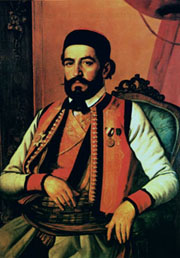Petar II Petrović Njegoš: Difference between revisions
imported>Regina Bouillon mNo edit summary |
imported>Regina Bouillon No edit summary |
||
| Line 1: | Line 1: | ||
Petar II. Petrović Njegoš (1813-1851), Serbian Poet | [[Image: Njegos.jpg|thumb|Petar II. Petrović Njegoš]] | ||
Petar II. Petrović Njegoš (1813-1851), Serbian Poet, Prince-Bishop | |||
==Biography== | ==Biography== | ||
Revision as of 12:47, 21 November 2007
Petar II. Petrović Njegoš (1813-1851), Serbian Poet, Prince-Bishop
Biography
Njegoš was born in Njeguši, Montenegro (Crna Gora). His uncle Petar I. was a powerful Prince-Bishop of Montenegro. He was able to unite his people, though his territory was not officially recognized.
The young Njegoš was not educated in a regular way. He picked up some knowledge in the monastery Savina in Topla and learned a lot from the writer Sima Milutinović Sarajlija, the bishop’s secretary. Though having no theological education, young Njegoš was installed as Prince-Bishop after the death of his uncle in 1830. The political situation was most constrained. Turkish and Austrian forces were trying to influence the country. The patriarchal structure in Montenegro was very firm and opposing modern administration. The cultural level was very low at that time. Njegoš had to fight problems from outside as well as from inside.
Njegoš travelled a lot and learnt languages. He also did a lot of research about culture and literature of different countries. Though he was a very strong man, all those efforts weakened him. He suffered from Tubercolosis. He tried to cure his disease in Italy, but in vain. He died in Cetinje (Montenegro) and is buried on top of the Lovćen Mountain.
Works
Njegoš already wrote poems when he was a boy. He was influenced a lot by Sima Milutinović. In his “chants of freedom” (Svobodijada, 1835), he described the montenegrinian fight against the Turkish power in the beginning of the 18th century.
The first important publication was “The Torch of Microcosm” (Luča mikrokozma, 1845). This philosophical epos describes man as an angel, who had revolted against god together with satan. He regretted, was brought back to earth, but not only to live in poverty, but also to remember the good days.
The climax was his epos “The Mountain Wreath” (Gorski vijenac, 1847). In the centre of this work, there is bishop Danilo and his fight against the Renegades, i.e. the Montenegrinian Moslems. “The Mountain Wreath” is a thorough description of Montenegrinian culture and everyday life in the beginning of the 18th century and in the time of Njegoš.
In 1851, “Little Stephan” (Šćepan Mali) appeared. This book is about a man named Stephan who had come to Montenegro in the 18th century and had claimed that he was the Russian Tsar.
Literature
- Petronijević, Branislav, Folozofija u “Gorskom vijencu”, Belgrade 1920.
- Barac, Antun, Geschichte der jugoslavischen Literaturen, Wiesbaden 1977.
- Milovan Đilas: Njegoš - pjesnik, vladar, vladika, 1988.
External Links
- „The Mountain Wreth“ – full Serbian Text http://alas.matf.bg.ac.yu/~mr99164/tekstovi/gv.html
- About life and work of Njegoš (in English language) http://www.njegos.org/siteindex/petrovic.htm
- Vast material about Njegos with interesting photos (in Serbian language) http://www.ppnjegos.org/
